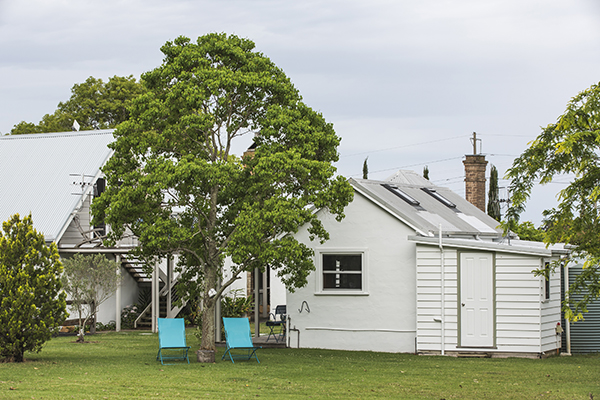We first started keeping hens six years ago, with the purchase of five Isa Browns and two Black Australorps, and all seven lived quite happily in our front yard. We had a plentiful supply of fresh eggs for a couple of years, but then production became somewhat erratic, which is apparently quite typical with hens. In our second year two of the Isa Browns died and then the third year one more fell off the perch and our brood was reduced to only four. Desiring to increase our numbers, but hesitant as to how well they would be received by the current residents of the coop, we introduced two delightful newbies to the flock. A pair of heritage breed Brahma hens, with gorgeous grey plumage and crazy feathers on their feet. Yes, they were mercilessly, bullied by the two Isa Browns on arrival. However, the pair of Black Australops offered some camaraderie and eventually everyone found their place in the pecking order. Egg production lifted again and we were doing well with our six girls, three pretty pairs of brown, black and grey.
Eighteen months later another of the Isa Browns died and sadly one of the two Brahma drowned in a flood we had on our property, middle of last year. We were back to four again. Our coop was looking a little worse for wear, so prior to bringing in further hens, we decided to rebuild a new pad for our existing girls. Completely out of recycled materials we crafted a new abode, with a little more perch space and an extra laying box, creating added room so we could comfortably accommodate a few more hens and eggs.
Since the Black Australorps had been the most resilient of our flock, we purchased another two of those, along with two White Leghorns with vibrant red combs. Our numbers now shot up to eight hens and we were confidently expectant for increased egg production. I’m not sure if it was all too much for the final Isa Brown, to have to welcome another round of newbies, but just weeks after their arrival, she departed and we buried her in the veggie patch.
Now we have seven hens, just like when we began this adventure of keeping hens. The four newbies are laying fervently and the remaining three, are rising to the challenge, meaning we are inundated with eggs daily. So of course it’s mainly up to me to get cooking all things eggs. I’ve been soft poaching with the perfect runny yoke, scrambling with finely sliced silverbeet or basil from the garden, boiling with buttery sourdough soldiers and frying for the popular weekend bacon and egg rolls. But it is still not enough, the eggs just keep on coming! So here’s a delicious recipe from the Breakfasts chapter of my second cookbook Our Delicious Adventure – Recipes and Stories of Food and Travel, Potato, Leek and Gruyere Frittata and funnily enough, although it contains six eggs, it really doesn’t taste all eggy… x j
POTATO, LEEK AND GRUYERE FRITTATA
Frittatas are such an easy meal to throw together when time is short and the fridge is looking bare. Although I’ve used potato, leek and Gruyère, you can substitute any vegetable, herb or cheese. Perfect served hot or cold, either on its own or with a green salad.
serves 8
V GF
what you need
600g potatoes, peeled and finely sliced
2 tbsp olive oil
2 leeks, halved, washed and finely sliced
2 garlic cloves, crushed
6 eggs
100 ml cream
½ tsp sea salt
freshly ground black pepper
200g gruyere, grated
60g parmesan, finely grated
1 sprig rosemary, just the leaves
what you do
1. Steam or boil the potato slices until tender but not falling apart.
2. Using a 26cm (top measurement) ovenproof frying pan (with a lid), heat the oil on a medium heat. Add the leek and cook for 4-5 minutes, until soft and translucent. Stir in the garlic and cook for 1 minute. Remove from pan and set aside in a small bowl.
3. In a large bowl lightly beat the eggs and cream, then add the cooked leeks and garlic. Mix to combine. Season with salt and pepper.
4. Preheat the oven grill to 200°C (180°C fan forced) and line the base of the frying pan with a sheet of non-stick baking paper, cut to the size of the pan base. (This will help avoid the frittata catching and making it difficult to get it out of the pan once cooked.)
5. Layer half the potato slices onto the base of the pan, then sprinkle half the gruyere and a quarter cup of parmesan over the top. Pour on half the egg mixture. Repeat with the remaining potato slices, gruyere, another quarter cup of parmesan and then the remaining egg mixture. Make sure the egg and leek mixture is spread evenly across the pan. Finally, sprinkle remaining parmesan and the rosemary leaves over the top.
6. Cook the frittata on the stove over a medium-low heat for 8-10 minutes with the lid on. Remove the lid and finish under the grill for 3-5 minutes to brown the top. Loosen the frittata by running a palette knife around the edge. Allow to sit in the pan for 15 minutes. Turn or slide onto a large cutting board and cut into wedges to serve.
Note: If you do not have an ovenproof frying pan, the frittata can be made in a shallow dish or small lasagne dish, at step 5 cook completely in the oven at 180°C for 15 minutes. Finish under the grill for 3-5 minutes to brown the top.
leeks sit in the same vegetable family as garlic and onions - the Allium vegetables. With a more gentle and sweeter flavour than onions, leeks add a subtle touch to recipes without overtaking other flavours. Fairly low in calories, leeks contain many significant flavonoid antioxidants, minerals and vitamins, especially vitamin A, folic acid and iron.






































